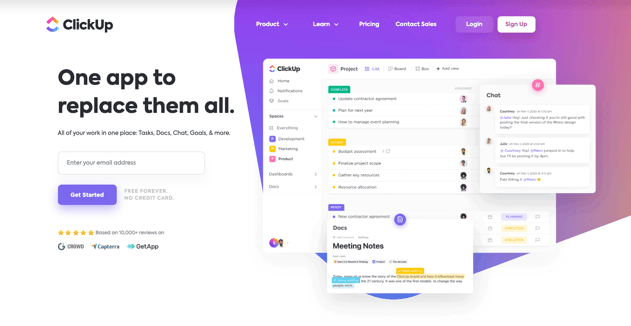What is a sales pipeline and how to build yours
Sourcing, connecting with, and converting leads can be a daunting task. Get the tools and steps you need to build a solid sales pipeline to meet your targets and grow your revenue.

Cristian Ungureanu

Ready to book more meetings?
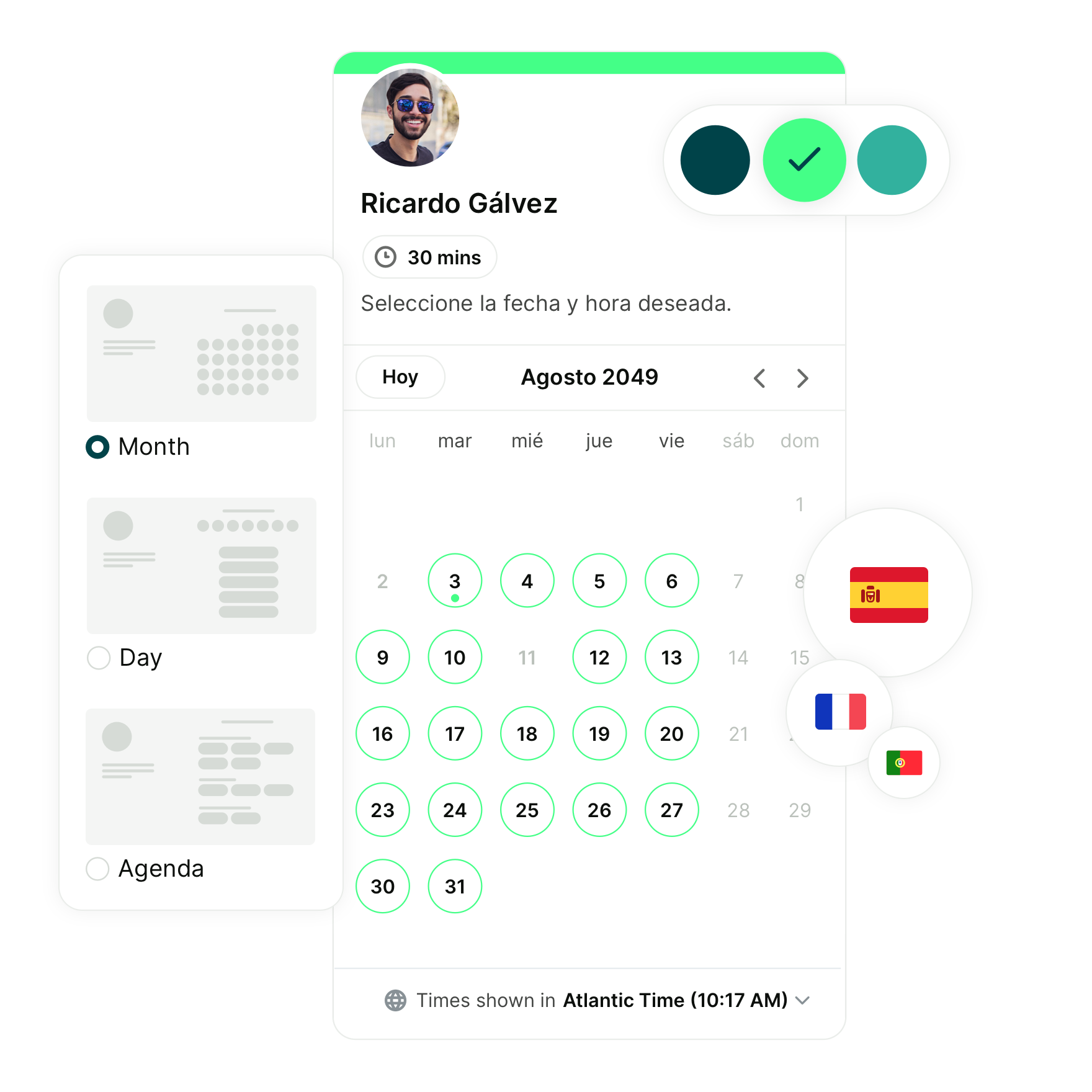
The more leads you can move through your sales pipeline, the more revenue you can generate, and the faster you can grow your business.
However, most companies don’t have a clear system for moving leads through their sales pipeline. If you can master it, you’ll be at a significant advantage over your competition and can scale your business faster.

Ready?
Let’s jump right in.
What is a sales pipeline?
Your sales pipeline gives you an overview of how many leads you have at each stage of the sales process. A sales pipeline helps you understand where leads are in your sales process and dictates the actions your sales team needs to take at each stage of the pipeline.
Sales pipeline vs. sales funnel: what’s the difference?
The terms sales pipeline and sales funnel are often used interchangeably.
However, there is a difference.
A sales funnel is all about the number of people you’re moving through your pipeline.
A sales pipeline is focused on the actions you need to take at each stage of the pipeline to move a prospect towards the next step. When looking at your sales pipeline, be on the lookout for sales acceleration opportunities.
For the purpose of this article, we’ll be using the term pipeline.
What are the stages in a sales pipeline?
1. Setting your sales pipeline targets
While this isn’t an official step in a pipeline, the first thing any sales leader needs to do is set targets or OKRs for your sales pipeline.
When you have sales pipeline targets in place, you can work backward from those targets.
Here are some examples of sales pipeline targets and OKRs you can set:
- Send cold emails to 100 new prospects per week
- Schedule demos with ten sales leads per week
- Close five new deals per week
- Secure $100,000 of new revenue in Q1
While these might look simple at first, they give you and your team action-based targets that you can use to keep leads moving through your pipeline and generate more revenue.
2. Prospecting and creating a qualified sales pipeline
The first step in your sales pipeline is to build a qualified list of prospects. This is an important step because the more qualified your prospects are for your product or service, the more likely they are to reply to your outreach and be interested in a conversation.
Depending on your method of sales outreach, the number of prospects you’ll need to source will vary.
Here are some examples of targets you can set for various campaign types:
- For a targeted multichannel ABM campaign: Source 50 prospects per month
- For a cold email campaign: Source 500 prospects per month
- For a LinkedIn outreach campaign: Source 500 prospects per month
- For a paid advertising campaign: Source 1,000 prospects per month
Depending on the type of outreach you’re running, the number of prospects you need to source will differ.
To find prospects that match your buyer persona, you can use sales prospecting tools such as:
These prospect tools let you add criteria for a prospect, such as company size, location, job title, or even the software they use on their website.
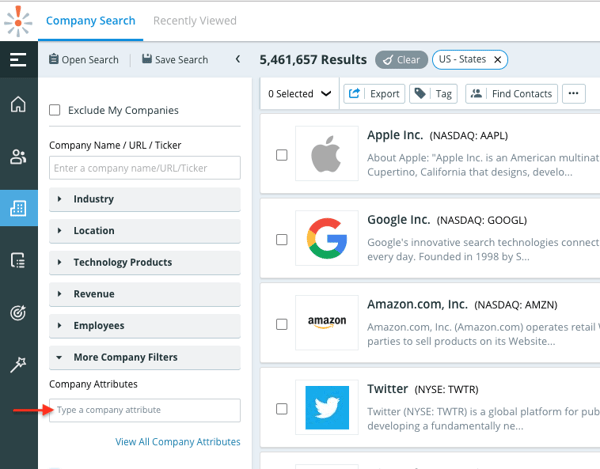
Filter for any type of prospect using ZoomInfo’s advanced filters
They’ll generate a list of prospects matching your criteria, and you can export the prospect list to a CSV to use in your sales outreach tools.
3. Reaching out to prospects
The next step in your sales pipeline is to get in touch with your prospects.
This step is key. If your first contact point with a prospect demonstrates that you understand the pain points in their business and that you’re reaching out to them personally, rather than throwing them onto a generic email list, there’s a strong chance they’ll be happy to talk.
There are several channels you can use to start conversations with qualified prospects.
Here are some of the most effective channels to use at this stage:
- Cold email: Cold email gives you direct access to your prospect’s inbox. Targeted campaigns using personalized emails can get you a 20% reply rate and ensure you’re regularly having conversations with qualified leads.
- LinkedIn message outreach: B2B decision-makers around the world rely on LinkedIn for networking and growing their following. You can run outreach campaigns via InMail to get your message seen by decision-makers as they’re browsing the platform.
- Cold calling: If you want to strike up a conversation immediately, cold calling is the way to go. It’s a powerful way to start a conversation with a decision-maker and it’s one of the most personal ways to do so.
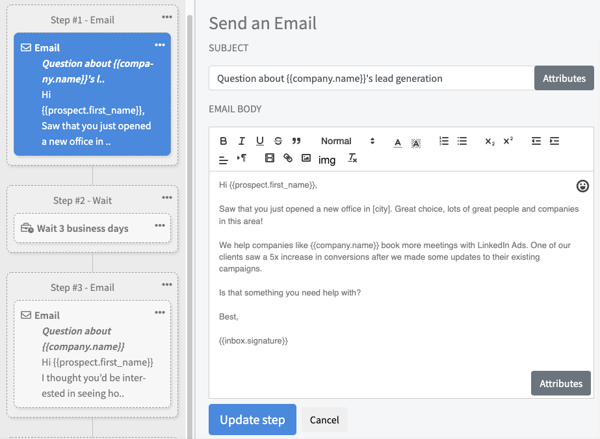
An example cold outreach campaign in QuickMail
If your prospect doesn’t reply to your initial outreach, whether it’s a LinkedIn message, cold email, or another contact point, then you’ll need to follow up.
Following up is a vital part of your outreach process. If you do it politely and your product/service solves a real problem for your prospects, they’ll be grateful that you followed up with a reminder.
4. Booking demo calls with leads
When your leads reply to you, it’s time to get them on a call with you.
This tends to be an area where teams struggle with speed to lead. For many sales teams, this can be a difficult part of your sales pipeline, as it often involves back-and-forth emails to find a time that works for both of you.
To streamline this stage of your sales pipeline, use a scheduling tool like YouCanBook.me.
After connecting YouCanBook.me with your calendar, you can quickly send an invite to your sales prospects with pre-set times available.
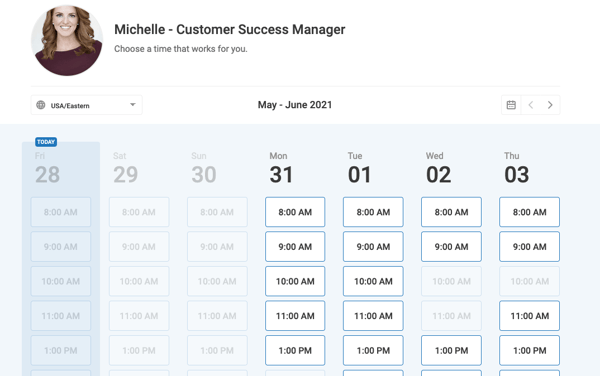
Meeting invites sent using YouCanBook.me make it simple to show availability
They can choose the best time for them, and the meeting will be automatically populated on their calendar with all of the key details and links they need.
Before the meeting, YouCanBook.me will automatically remind your prospects that they have an upcoming meeting, which reduces the risk of no-shows.
You can even include your calendar invite link in your email signature, which can be a simple but effective way to ensure it’s always easy for your leads to book a call with you.
Increasing your meeting booking rate is one of the best ways to close more deals, so you need to spend time optimizing this step of your sales pipeline.
5. Sending proposals and closing deals
So, you’ve had a successful meeting with a lead. They’ve expressed interest, and want to get started with your product/service.
Next, you need to send your proposal and encourage them to sign it.
This stage can often result in delays, and as your prospect passes the proposal through their company, you’re often left in the dark about what’s going on. Using RFP agents can help streamline this process, ensuring proposals are consistent, accurate, and faster to deliver.
Another way to optimize this stage of your sales pipeline and move leads through this stage faster, you can use proposal software.
The benefits of proposal software over sending your proposals as regular PDFs or Google Docs is that there are proposal templates to speed up proposal creation, plus, analytics built-in.
These tools can track any activity on your proposal, such as the number of times it’s been opened, downloaded, and whether or not it has been signed.
Tools you can use for this include:
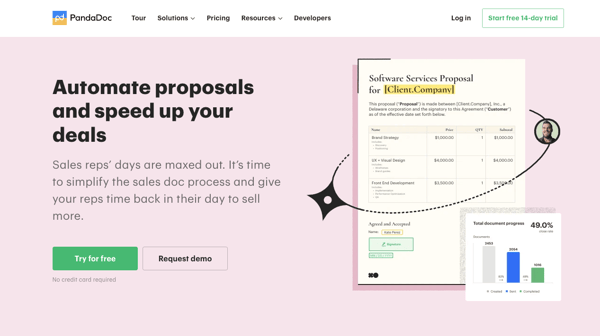
Speed up the proposal stage using a tool like PandaDoc
You’ll know exactly when to send a follow-up email to check in with your prospect, and can ensure they don’t forget about your proposal.
Once your proposal has been approved and signed, it’s up to you to fully onboard your new client and start delivering the value promised in your initial outreach to them.
What sales pipeline metrics do you need to track?
There are different metrics to track at each stage of your sales pipeline. They all provide insights into the health of your pipeline and can help you make improvements.
- Reply rate to cold emails: Your reply rate is one of the first indicators of whether your outreach is successful. Aim for a 10-20% reply rate, and if you’re seeing lower than that, consider if your prospects are a perfect fit or if your email templates need to be reworked to further highlight the benefits to your recipient.
- Meeting booking rate: The number of meetings you book with prospects shows how well qualified your list is, and how effective your sales pitch is. The more conversations you have, the faster you can learn about your prospects’ pain points and help solve them.
- Revenue in the pipeline: A key indicator of sales pipeline health is how much potential revenue is in your pipeline. You can measure this by looking at the number of prospects your sales team is talking to, then assigning your average deal size to each one.
- Total revenue generated: The ultimate metric to judge the health of your pipeline is how much revenue you’re generating. If your revenue matches your targets, you know your actions at each stage of the pipeline are having the intended effect and you can start to find ways to scale up.
Naturally, you’ll have other metrics you need to track based on your unique sales pipeline, however, these are some that will help you get started with a data-driven approach.
4 powerful tools to manage your sales pipeline
1. YouCanBookMe
 If you want to book more meetings with sales leads, YouCanBook.me is an essential tool.
If you want to book more meetings with sales leads, YouCanBook.me is an essential tool.
Once your prospect is ready to have a meeting to learn more about your product or service, you can send them your YouCanBook.me invite link. You can also include the link in your email signature, on your landing page, or wherever else you reach leads to ensure they can schedule with you when their interest is highest.
The link will automatically show all available times on your calendar, converted to your sales lead’s time zone so that they can book at the best time for them.
Before your meeting, YouCanBook.me will automatically send email or SMS reminders to ensure your meeting attendance rate is always high. It also connects with all of your other sales tools thanks to a Zapier integration, and can fit into any workflow you need it to.
2. UpLead
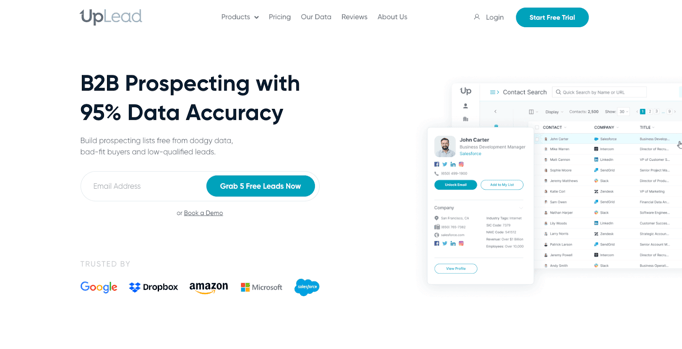
If you want to identify qualified leads for your business, UpLead is an excellent prospect and email-finding tool. It’s a B2B database containing millions of decision-makers that you can use to find anyone matching specific criteria.
You can sort by demographic, firmographic, and technographic data.
When you have your list of prospects, you can export them to a CSV file that you can use in your outreach software.
Using a prospecting tool like this will speed up the prospecting process without compromising on quality, giving you more time to spend having conversations with qualified prospects.
3. QuickMail
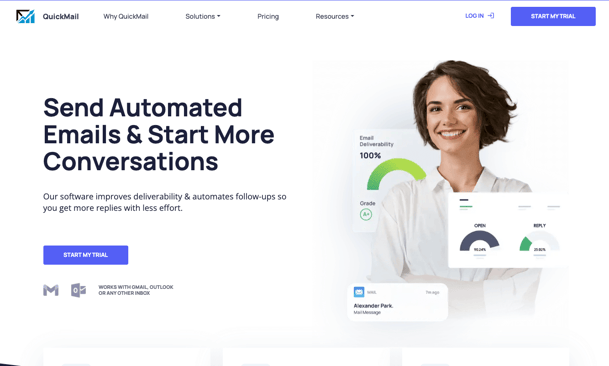
When you’re ready to start reaching out to your prospects via cold email, you can use QuickMail.
QuickMail is a cold outreach platform that lets you send completely personalized emails, as well as follow-ups, to your prospects at scale.
After bringing in your prospect list, you can write your templates and ensure they’re personalized to every person on your list using attributes. When your email templates are sent, each one will be unique to your prospects to boost your chances of a reply.
There are powerful cold email deliverability tools included in QuickMail’s plans, so your emails will never land in the spam folder.
It’s the best way to start having more conversations using cold email.
4. ClickUp
Managing your sales pipeline can be a full-time job in itself. To make sure you always know what stage all of your leads are at, you can use a tool like ClickUp to build a CRM.
ClickUp lets you create a CRM with as few or as many pipeline stages as you require. You can connect it with your other tools, such as YouCanBook.me or QuickMail using Zapier, and have prospects automatically be assigned tags or moved through the pipeline based on actions they’ve taken.
You and your team can easily get a snapshot of where every lead is, and how healthy your sales pipeline is at any time you need to.
Conclusion
The health of your sales pipeline has a major effect on the health of your business. That’s why it’s vital to always keep your prospects moving through and engage them at each stage.
The stages we’ve outlined in this guide are all worth paying attention to. Set your targets for each stage, and regularly review if prospects are moving through it as you expect. If not, you can make adjustments to ensure they do.
There are various tools you can use to streamline your workflow, that can all help.
However, the most important factor will always be how qualified your prospects are, and how well you can convey the benefits to them. If you can do that, moving prospects through your sales pipeline will be a breeze.
Subscribe to our newsletter
Get productivity tips, news, articles and resources.
Written by
Cristian Ungureanu
Cristian is a growth marketer for QuickMail, a tool that helps connect businesses through cold outreach. He enjoys writing about sales, cold email, and growth hacks. When he's not dreaming up his next growth power move, you can find him playing in the backyard with his french bulldog Olivia.


